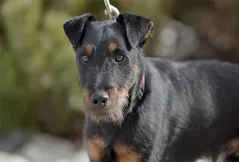
Norfolk Terrier
Norfolk Terriers are little, cute, and loyal, and they will gladly curl up in your lap, but don’t dare call them lapdogs.
Overall Status
| Height | 9-10 inches |
| Temperament | Fearless, Alert, Fun-Loving |
| Weight | 11-12 pounds |
| Life Expectancy | 12-16 years |
| Coat Color | Black and Tan, Red |
| Barking Level | Likes To Be Vocal |
Quick Factors
| Playfulness | |
| Dog Friendly | |
| Exercise Need | |
| Grooming Needs | |
| Strangers Friendly | |
| Family Affectionate |
Daily Care
Grooming Tips
The Norfolk Terrier has a hard, wiry, straight coat with a heavier amount of hair on the neck and shoulders forming a protective mane. Trimming isn’t necessary, but the coat does need to be hand-stripped twice a year, a time-consuming process of pulling out loose hair with a tool called a stripping knife. In the meantime, brush or comb the coat weekly.If you choose not to strip the coat, the Norfolk will have a scruffy appearance, which some people like. The drawback to this is that the coat will shed more, especially as the dog matures. Stripping the coat has other benefits as well. A stripped coat sheds dirt and is water resistant. Terriers whose coats are stripped need fewer baths.The ears should be checked on a regular basis for signs of wax buildup, irritation or infection. Clean them with a cotton ball and a veterinarian-approved cleanser; never use a cotton swab in a dog's ear canal. Small dogs are prone to dental problems, and teeth should be brushed on a weekly basis to prevent tartar buildup, promote gum health and keep bad breath at bay. Trim nails monthly if the dog does not wear the toenails down naturally outdoors.
Exercise Tips
These little dogs were bred to work. They are energetic and thrive on an active life, and need to be taken on a daily walk. They can jog for short distances.A shorter walk in the morning would be fine, but a longer more interesting one in the afternoon is a must with as much of the lead time as possible. These dogs also like to be able to roam around a back garden so they can really let off steam. However, the fencing has to be extremely secure to keep these active, high-energy dogs in because if they find a weakness in the fence, they will soon escape and could get into all sorts of trouble, bearing in mind that Norfolk Terriers are experts when it comes to digging their way out of a garden.With this said, Norfolk puppies should not be over exercised because their joints and bones are still growing. This includes not letting a dog jump up and down from furniture or going up or down the stairs. Too much pressure placed on their joints and spines at an early age could result in a dog developing serious problems later in their lives.
Feeding Tips
If you get a Norfolk Terrier puppy from a breeder, they would give you a feeding schedule and it's important to stick to the same routine, feeding the same puppy food to avoid any tummy upsets. You can change a puppy's diet, but this needs to be done very gradually always making sure they don't develop any digestive upsets and if they do, it's best to put them back on their original diet and to discuss things with the vet before attempting to change it again.Older dogs are not known to be fussy eaters, but this does not mean they can be given a lower quality diet. It's best to feed a mature dog twice a day, once in the morning and then again in the evening, making sure it's good quality food that meets all their nutritional requirements.Treatscan be an important aid in training, but giving too many can cause obesity. Learn about whichhuman foodsare safe for dogs, and which are not. Check with your vet if you have any concerns about your dog’s weight or diet.Clean, fresh water should be available at all times.
Health Tips
The Norfolk Terrier is a generally healthy breed. However, common concerns may include mitral valve disease, luxating patellas, cataracts, lens luxation and glaucoma.A Norfolk’steethshould be brushed often using a toothpaste formulated for dogs. Regular visits to the vet for checkups and parasite control help to ensure your dog will have a long, healthy life.
Trainability
Even though this is a terrier, Norfolks are easier to train. This is an intelligent dog, so be sure to keep training sessions upbeat and interesting – repetition can bore them. As with most breeds, you need to use positive reinforcement to train the Norfolk Terrier. If you are harsh with this breed, you’ll only get defensive behavior in return.Earlysocializationandpuppy training classesare recommended to ensure that the dog grows into a well-adjusted, well-mannered companion. A Norfolk travels well: He’s portable, adaptable, and up for anything.
History
Originally from the east-central portion of England, the Norfolk Terrier can be traced back to the early part of the twentieth century. A cross breed ofGlen of Imaal Terrierswith a working terrier fromNorwicharea began the breed and it was then steadily crossbred across the entire region. It was not long before the breed spread to North America, where it became known as the Jones Terrier for many years before being called the Norfolk Terrier. The Norwich Terrier and Norfolk Terrier are quite similar in appearance and can be tough to tell apart.In 1964, England’s Kennel Club separated the two varieties, calling the drop-eared dogs Norfolk Terriers. The American Kennel Club followed suit in 1979. Today the Norfolk ranks 117th among the breeds registered by the AKC.






